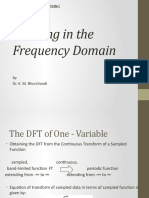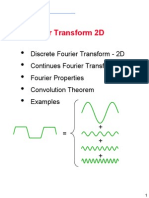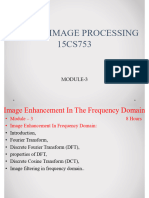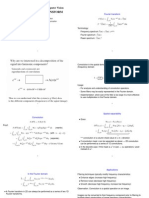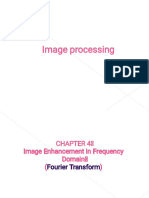Digital Image Processing Filtering in The Frequency Domain
Uploaded by
Madhuri PotluriDigital Image Processing Filtering in The Frequency Domain
Uploaded by
Madhuri PotluriDigital Image Processing
Chapter 4
Filtering in the Frequency Domain
4. Filtering in the Frequency Domain
1. Background
2. Preliminary Concepts
3. Sampling and the Fourier Transform of Sampled Functions
4. The Discrete Fourier Transform of One Variable
5. Extension to Functions of Two Variables
6. Some Properties of the 2-D Discrete Fourier Transform
7. The Basics of Filtering in the Frequency Domain
8. Image Smoothing using Frequency Domain Filters
9. Image Sharpening using Frequency Domain Filters
10. Selective Filtering
© 1992–2008 R. C. Gonzalez & R. E. Woods
Digital Image Processing
Chapter 4
Filtering in the
Frequency Domain
4.1 Background
Fourier Series and Transform
Jean-Baptiste Fourier (1768)
•Any periodic function can be expressed as a
weighted sum of sines and/or cosines (Fourier
series)
•Other functions can be expressed as an integral
of sines and/or cosines multiplied by a weighing
function (Fourier Transform)
•Functions can be recovered by the inverse
operation with no loss of information
• Applications to Image Enhancement
© 1992–2008 R. C. Gonzalez & R. E. Woods
Digital Image Processing
Chapter 4
Filtering in the Frequency Domain
2. Preliminary Concepts
1. Fourier Series
If f(t) is a periodic function of a continuous variable t, with period T
Where:
© 1992–2008 R. C. Gonzalez & R. E. Woods
Digital Image Processing
Chapter 4
Filtering in the Frequency Domain
4.2.3 Impulses and their Shifting Property
Unit impulse of a continuous variable t located at t=0 :
and
Shifting property
:
(if f(t) continuous at t=0 )
© 1992–2008 R. C. Gonzalez & R. E. Woods
Digital Image Processing
Chapter 4
Filtering in the Frequency Domain
Unit discrete impulse located at x=0 :
Sifting property :
© 1992–2008 R. C. Gonzalez & R. E. Woods
Digital Image Processing Chapter 4
Filtering in the Frequency
Domain
Impulse train : sum of infinitely many periodic impulses T units apart:
© 1992–2008 R. C. Gonzalez & R. E. Woods
Digital Image Processing
Chapter 4
Filtering in the Frequency Domain
4.2.4 The Fourier Transform of Functions of One Continuous Variable
Fourier Transform of a continuous function f(t) of a continuous variable t :
Inverse Fourier Transform:
© 1992–2008 R. C. Gonzalez & R. E. Woods
Digital Image Processing
Chapter 4
Filtering in the Frequency
Domain
Example :
© 1992–2008 R. C. Gonzalez & R. E. Woods
Digital Image Processing
Chapter 4
Filtering in the Frequency
Domain
Example 2 : Fourier Transform of a unit impulse located at the origin:
Fourier Transform of a unit impulse located at t = t0 :
© 1992–2008 R. C. Gonzalez & R. E. Woods
Digital Image Processing
Chapter 4
Filtering in the Frequency Domain
Example 2 : Fourier Transform S() of an impulse train with period T :
Periodic function with period T =>
Where :
=>
Also an impulse train, with period 1/T
© 1992–2008 R. C. Gonzalez & R. E. Woods
Digital Image Processing
Chapter 4
Filtering in the Frequency Domain
4.2.5 Convolution
Convolution of functions f(t) and h(t), of one continuous variable t :
Fourier Transform pairs:
© 1992–2008 R. C. Gonzalez & R. E. Woods
Digital Image Processing
Chapter 4
Filtering in the Frequency Domain
4.3 Sampling and the Fourier Transform of Sampled Functions
4.3.1 Sampling
Model of the sampled function:
multiplication of f(t) by a sampling
function equal to a train of impulses T
units apart
© 1992–2008 R. C. Gonzalez & R. E. Woods
Digital Image Processing
Chapter 4
Filtering in the Frequency Domain
4.3.2 The Fourier Transform of Sampled Functions
Infinite, periodic sequence of copies of F(), continuous
Separation between copies determined by 1/T
© 1992–2008 R. C. Gonzalez & R. E. Woods
Digital Image Processing Chapter 4
Filtering in the
Frequency Domain
4.3.3 The Sampling Theorem
© 1992–2008 R. C. Gonzalez & R. E. Woods
Digital Image Processing
Chapter 4
Filtering in the
Frequency Domain
A function f(t) whose Fourier transform is zero
for values of frequencies outside a finite
interval (band) [- max, max] about the origin is
called a band-limited function
Sufficient separation guaranteed if:
Sampling Theorem:
A continuous, band-limited function can be recovered completely
from a set of its samples if the samples are acquired at a rate
exceeding twice the highest frequency content of the function
NB: Sampling at: Nyquist rate
© 1992–2008 R. C. Gonzalez & R. E. Woods
Digital Image Processing
T. Peynot
Chapter 4
Filtering in the Frequency
Domain
=> Recover f(t) using the inverse FT:
Example: ideal lowpass filter
© 1992–2008 R. C. Gonzalez & R. E. Woods
Digital Image Processing
T. Peynot
Chapter 4
Filtering in the
Frequency Domain
4.3.4 Aliasing
Effect of under-sampling a function
Transform corrupted by frequencies
from adjacent periods
NB: the effect of aliasing can be reduced
by smoothing the input function to
attenuate its higher frequencies: anti-
aliasing.
Has to be done before the sampling
© 1992–2008 R. C. Gonzalez & R. E. Woods
Digital Image Processing
T. Peynot
Chapter 4
Filtering in the Frequency Domain
4.3.4 Aliasing
Illustration: sampling a sine wave of period 2s
© 1992–2008 R. C. Gonzalez & R. E. Woods
Digital Image Processing
T. Peynot
Chapter 4
Filtering in the Frequency Domain
4.3.5 Function Reconstruction (Recovery) from Sampled Data
Recovery expressed in the spatial domain:
© 1992–2008 R. C. Gonzalez & R. E. Woods
Digital Image Processing
T. Peynot
Chapter 4
Filtering in the Frequency Domain
4. The Discrete Fourier Transform (DFT) of One Variable
1. Obtaining the DFT from the Continuous Transform of a Sampled Function
fn : discrete function
© 1992–2008 R. C. Gonzalez & R. E. Woods
Digital Image Processing
T. Peynot
Chapter 4
Filtering in the Frequency Domain
4. The Discrete Fourier Transform (DFT) of One Variable
1.Obtaining the DFT from the Continuous Transform of a Sampled Function
Given a set {f(x)} of M samples of f(t) the DFT is of f(x) is:
Inverse Discrete Fourier Transform (IDFT):
© 1992–2008 R. C. Gonzalez & R. E. Woods
Digital Image Processing
T. Peynot
Chapter 4
Filtering in the Frequency Domain
4. The Discrete Fourier Transform (DFT) of One Variable
1.Obtaining the DFT from the Continuous Transform of a Sampled Function
Both forward and inverse discrete transforms are infinitely periodic, with period M
Where k is an integer
Discrete equivalent of the convolution:
© 1992–2008 R. C. Gonzalez & R. E. Woods
Digital Image Processing
T. Peynot
Chapter 4
Filtering in the Frequency Domain
4.4 The Discrete Fourier Transform (DFT) of One Variable
4.4.2 Relationship between the Sampling and Frequency Intervals
If f(x) consists of M samples of a function f(t) taken T units apart, the duration of
the record comprising the set {f(x)} is:
T = M T
The corresponding spacing in the discrete frequency domain is:
u = 1 / (M T) = 1/T
The entire frequency range spanned by the M components in the DFT is:
M u = 1/ T
© 1992–2008 R. C. Gonzalez & R. E. Woods
Digital Image Processing
T. Peynot
Chapter 4
Filtering in the Frequency Domain
5. Extension to Function of Two Variables
1.The 2-D impulse and its Sifting Property
Impulse of two continuous variables t and z :
Impulse of two continuous variables t and z :
© 1992–2008 R. C. Gonzalez & R. E. Woods
Digital Image Processing
T. Peynot
Chapter 4
Filtering in the Frequency Domain
5. Extension to Function of Two Variables
1.The 2-D impulse and its Sifting Property
Sifting property:
© 1992–2008 R. C. Gonzalez & R. E. Woods
Digital Image Processing
T. Peynot
Chapter 4
Filtering in the Frequency Domain
5. Extension to Function of Two Variables
1.The 2-D impulse and its Sifting Property 2-
D discrete impulse:
Sifting property:
© 1992–2008 R. C. Gonzalez & R. E. Woods
Digital Image Processing
T. Peynot
Chapter 4
Filtering in the Frequency Domain
4.5 Extension to Function of Two Variables
4.5.2 The 2-D Continuous Fourier Transform Pair
f(t,z) continuous function of two continuous variables t and z, the 2-D continuous
Fourier transform pair is given by:
and
© 1992–2008 R. C. Gonzalez & R. E. Woods
T. Peynot
Digital Image Processing Chapter 4
Filtering in the Frequency Domain
Example: Obtaining the 2-D Fourier transform of a simple function
© 1992–2008 R. C. Gonzalez & R. E. Woods
Digital Image Processing
T. Peynot
Chapter 4
Filtering in the Frequency Domain
4.5.3 Two-Dimensional Sampling and the 2-D Sampling Theorem
Sampling in 2-D can be modeled using the sampling function (2-D impulse train):
Multiplying f(t,z) by yields the sampled function
© 1992–2008 R. C. Gonzalez & R. E. Woods
Digital Image Processing
T. Peynot
Chapter 4
Filtering in the Frequency Domain
f(t,z) is said to be band-limited if its Fourier transform is 0 outside of a rectangle
[- max, max] and [- max, max]
2-D sampling theorem:
A continuous, band-limited function f(t,z) can be recovered with no error from a
set of its sample if the sampling intervals are
and
© 1992–2008 R. C. Gonzalez & R. E. Woods
Digital Image Processing
T. Peynot
Chapter 4
Filtering in the Frequency Domain
4.5.4 Aliasing in Images
Example: sampling checkerboards whose squares are of size 16x6 pixels
Effects of aliasing can be reduced by slightly defocusing the scene to be digitized (attenuation of
high frequencies), before the image is sampled : anti-aliasing
© 1992–2008 R. C. Gonzalez & R. E. Woods
T. Peynot
Digital Image Processing Chapter 4
Filtering in the Frequency Domain
Effects of aliasing generally are worsened when the size of a digital image is reduced
Scaling: 50% Blurring prior to Scaling: 50%
© 1992–2008 R. C. Gonzalez & R. E. Woods
Digital Image Processing
T. Peynot
Chapter 4
Filtering in the Frequency Domain
Moiré patterns
In optics: beat patterns produced between two gratings of approximately equal spacing
© 1992–2008 R. C. Gonzalez & R. E. Woods
Digital Image Processing
T. Peynot
Chapter 4
Filtering in the Frequency Domain
4.5.5 The 2-D Discrete Fourier Transform and its Inverse
2-D Discrete Fourier Transform (DFT) of a digital image f(x,y) of size MxN:
Inverse Discrete Fourier Transform (IDFT):
© 1992–2008 R. C. Gonzalez & R. E. Woods
Digital Image Processing
T. Peynot
Chapter 4
Filtering in the Frequency Domain
6. Some Properties of the 2-D Discrete Fourier Transform
1. Relationships between Spatial and Frequency Domains
If T and Z are the separations between samples, the separations between the
corresponding discrete, frequency domain variables are:
and
© 1992–2008 R. C. Gonzalez & R. E. Woods
Digital Image Processing
T. Peynot
Chapter 4
Filtering in the Frequency Domain
4.6.2 Translation and Rotation
Translation:
and
Rotation (polar coordinates):
© 1992–2008 R. C. Gonzalez & R. E. Woods
Digital Image Processing
T. Peynot
Chapter 4
Filtering in the Frequency Domain
4.6.3 Periodicity
The 2-D Fourier Transform and its inverse are infinitely periodic in both directions:
and
where k1 and k2 are integers
© 1992–2008 R. C. Gonzalez & R. E. Woods
Digital Image Processing
T. Peynot
Chapter 4
Filtering in the
Frequency Domain
4.6.3 Periodicity
1-D Spectrum
Shift the data so that the origin,
F(0), is located at u0
If u0 = M/2
F(0) at the centre of the interval [0, M-1]
© 1992–2008 R. C. Gonzalez & R. E. Woods
Digital Image Processing
T. Peynot
Chapter 4
Filtering in the Frequency Domain
4.6.3 Periodicity
2-D Spectrum
Shift the data so that the origin, F(0,0), is
at the centre of the frequency rectangle
defined by [0, M-1] and [0, N-1]
© 1992–2008 R. C. Gonzalez & R. E. Woods
T. Peynot
Digital Image Processing Chapter 4
Filtering in the Frequency
Domain
FT Spectrum
Centered
FT Spectrum
© 1992–2008 R. C. Gonzalez & R. E. Woods
Digital Image Processing
T. Peynot
Chapter 4
Filtering in the Frequency
Domain
(Reminder)
© 1992–2008 R. C. Gonzalez & R. E. Woods
Digital Image Processing
T. Peynot
Chapter 4
Filtering in the Frequency Domain
4.6.4 Symmetry Properties
Example:
If f(x,y) is a real function,
its Fourier transform is
conjugate symmetric:
If f(x,y) is a imaginary, its Fourier transform is conjugate antisymmetric:
© 1992–2008 R. C. Gonzalez & R. E. Woods
T. Peynot
Digital Image Processing Chapter 4
Filtering in the Frequency Domain
4.6.4 Symmetry Properties
© 1992–2008 R. C. Gonzalez & R. E. Woods
Digital Image Processing
T. Peynot
Chapter 4
Filtering in the Frequency Domain
4.6.5 Fourier Spectrum and Phase Angle
The 2-D DFT can be expressed in polar form:
Where the magnitude
is called the Fourier (or frequency) spectrum, and
is the phase angle
Power spectrum:
NB: R and I are the real and imaginary parts of F(u,v)
© 1992–2008 R. C. Gonzalez & R. E. Woods
Digital Image Processing
T. Peynot
Chapter 4
Filtering in the Frequency Domain
4.6.5 Fourier Spectrum and Phase Angle
and
=>
Where denotes
the average value of f
MN usually large => |F(0,0)| typically is the largest component of the spectrum
© 1992–2008 R. C. Gonzalez & R. E. Woods
T. Peynot
Digital Image Processing Chapter 4
Filtering in the Frequency
Domain
FT Spectrum
FT Spectrum
(centered)
FT Spectrum
(centered + log)
© 1992–2008 R. C. Gonzalez & R. E. Woods
Digital Image Processing
T. Peynot
Chapter 4
Filtering in the Frequency
Domain
Original Image FT Spectrum
Spectrum is insensitive to
translation
But rotates by the same
angle
as the rotated image
© 1992–2008 R. C. Gonzalez & R. E. Woods
T. Peynot
Digital Image Processing Chapter 4
Filtering in the Frequency
Domain
Phase angle images:
© 1992–2008 R. C. Gonzalez & R. E. Woods
Digital Image Processing
T. Peynot
Chapter 4
Filtering in the Frequency
Domain
Phase angle
Reconstruction
using phase angle only
Reconstruction using Reconstruction using:
spectrum only • Right Spectrum
• Wrong Phase
© 1992–2008 R. C. Gonzalez & R. E. Woods
Digital Image Processing
T. Peynot
Chapter 4
Filtering in the Frequency Domain
4.6.6 The 2-D Convolution Theorem
2-D circular convolution :
2-D convolution theorem :
and conversely:
© 1992–2008 R. C. Gonzalez & R. E. Woods
Digital Image Processing
T. Peynot
Chapter 4
Filtering in the Frequency
Domain
Data from adjacent periods produce
wraparound error
=> Need to append zeros to both
functions
In 2-D, padd the two images array
of size
MxN by zeros
Padded images of size PxQ, with:
P 2M-1
and
Q 2N-1
© 1992–2008 R. C. Gonzalez & R. E. Woods
T. Peynot
Digital Image Processing Chapter 4
Filtering in the Frequency Domain
4.6.7 Summary of 2-D Discrete Fourier Transform Properties
© 1992–2008 R. C. Gonzalez & R. E. Woods
T. Peynot
Digital Image Processing Chapter 4
Filtering in the Frequency Domain
4.6.7 Summary of 2-D Discrete Fourier Transform Properties
© 1992–2008 R. C. Gonzalez & R. E. Woods
T. Peynot
Digital Image Processing Chapter 4
Filtering in the Frequency Domain
4.6.7 Summary of 2-D Discrete Fourier Transform Properties
© 1992–2008 R. C. Gonzalez & R. E. Woods
T. Peynot
Digital Image Processing Chapter 4
Filtering in the Frequency Domain
4.6.7 Summary of 2-D Discrete Fourier Transform Properties
© 1992–2008 R. C. Gonzalez & R. E. Woods
Digital Image Processing
T. Peynot
Chapter 4
Filtering in the Frequency Domain
7. The Basics of Filtering in the Frequency Domain
1. Additional Characteristics of the Frequency Domain
FT Spectrum
© 1992–2008 R. C. Gonzalez & R. E. Woods
Digital Image Processing
T. Peynot
Chapter 4
Filtering in the Frequency Domain
4.7.2 Frequency Domain Filtering Fundamentals
Given a digital image f(x,y) of size MxN, the basic filtering equation is:
NB: product = array
multiplication
Filtered (output) image Filter function DFT if the input image
(or filter transfer
function)
NB: For simplification, use functions H(u,v)
that are centered symmetric about their
centre
+ centre F(u,v) multiplying f(x,y) by (-1)x+y
© 1992–2008 R. C. Gonzalez & R. E. Woods
T. Peynot
Digital Image Processing Chapter 4
Filtering in the Frequency
Domain
Lowpass filter highpass filter
© 1992–2008 R. C. Gonzalez & R. E. Woods
T. Peynot
Digital Image Processing Chapter 4
Filtering in the Frequency
Domain
Gaussian lowpass filter Gaussian lowpass filter
Without padding With padding
© 1992–2008 R. C. Gonzalez & R. E. Woods
T. Peynot
Digital Image Processing Chapter 4
Filtering in the Frequency
Domain
Periodicity Periodicity
without padding without padding
© 1992–2008 R. C. Gonzalez & R. E. Woods
Digital Image Processing
T. Peynot
Chapter 4
Filtering in the Frequency Domain
3. Steps for Filtering in the Frequency Domain
1. Given an input image f(x,y) of size MxN, obtain padding parameters P and
Q. Typically, P=2M and Q=2N.
2. Form a padded image fp(x,y) of size PxQ by appending the necessary number
of zeros to f(x,y).
3. Multiply fp(x,y) by (-1)x+y to centre its transform.
4. Compute the DFT, F(u,v), of the image from step 3.
5. Generate a real, symmetric filter function, H(u,v), of size PxQ with centre at
coordinates (P/2,Q/2). Form the product G(u,v)=H(u,v)F(u,v) using array
multiplication.
6. Obtain the processed image:
7. Obtain the final processed result, g(x,y), by extracting the MxN region from
the top, left quadrant of gp(x,y)
© 1992–2008 R. C. Gonzalez & R. E. Woods
Digital Image Processing
T. Peynot
Chapter 4
Filtering in the Frequency
Domain
4.7.3 Steps for Filtering in the Frequency Domain
2) Padding 3) (-1)x+y
1)
4) DFT
5) Filter H
6) Filtered
image (IDFT) 7) Final
Result
© 1992–2008 R. C. Gonzalez & R. E. Woods
Digital Image Processing
T. Peynot
Chapter 4
Filtering in the Frequency Domain
8. Image Smoothing using Frequency Domain Filters
NB: all filter functions are assumed to be discrete functions of size PxQ
1. Ideal Lowpass Filters
Ideal Lowpass Filter (ILPF) = 2-D lowpass filter that passes without attenuation all
frequencies within a circle of radius D0 from the origin and “cuts off” all frequencies
outside this circle
Where:
And D(u,v) is the distance between a point (u,v) and the centre of the frequency rectangle:
© 1992–2008 R. C. Gonzalez & R. E. Woods
Digital Image Processing
T. Peynot
Chapter 4
Filtering in the Frequency Domain
4.8.1 Ideal Lowpass Filters
The point of transition between H(u,v) = 1 and H(u,v) = 0 is called the cutoff
frequency
NB: an ILPF cannot be realized with real electronic components
© 1992–2008 R. C. Gonzalez & R. E. Woods
T. Peynot
Digital Image Processing Chapter 4
Filtering in the Frequency
Domain
r = 10
4.8.1 Ideal Lowpass Filters
Example:
r = 30
r = 60
r = 160 r = 460
© 1992–2008 R. C. Gonzalez & R. E. Woods
T. Peynot
Digital Image Processing Chapter 4
Filtering in the Frequency
Domain
Explaining the blurring and “ringing” properties of ILPFs
© 1992–2008 R. C. Gonzalez & R. E. Woods
Digital Image Processing
T. Peynot
Chapter 4
Filtering in the Frequency Domain
4.8.2 Butterworth Lowpass Filters
Transfer function of a Butterworth lowpass filter (BLPF) of order n and with
cutoff frequency at a distance D0 from the origin:
© 1992–2008 R. C. Gonzalez & R. E. Woods
T. Peynot
Digital Image Processing Chapter 4
Filtering in the Frequency Domain
4.8.2 Butterworth Lowpass Filters
© 1992–2008 R. C. Gonzalez & R. E. Woods
T. Peynot
Digital Image Processing Chapter 4
Filtering in the Frequency Domain
4.8.2 Butterworth Lowpass Filters
© 1992–2008 R. C. Gonzalez & R. E. Woods
Digital Image Processing
T. Peynot
Chapter 4
Filtering in the Frequency Domain
4.8.3 Gaussian Lowpass Filters
Gaussian Lowpass Filters (GLPFs) in two-dimensions:
( = measure of spread about the centre)
(D0 = cutoff frequency)
© 1992–2008 R. C. Gonzalez & R. E. Woods
T. Peynot
Digital Image Processing Chapter 4
Filtering in the Frequency Domain
4.8.3 Gaussian Lowpass Filters
© 1992–2008 R. C. Gonzalez & R. E. Woods
Digital Image Processing
T. Peynot
Chapter 4
Filtering in the Frequency
Domain
© 1992–2008 R. C. Gonzalez & R. E. Woods
Digital Image Processing
T. Peynot
Chapter 4
Filtering in the Frequency Domain
4.8.4 Additional Examples of Lowpass Filtering
Character recognition (machine perception):
Blurring to fill “visual gaps” => help reading broken characters
© 1992–2008 R. C. Gonzalez & R. E. Woods
Digital Image Processing
T. Peynot
Chapter 4
Filtering in the Frequency Domain
Printing and publishing industry: “cosmetic” processing
GLPF
(Do=80)
Original
Image
GLPF
(Do=100)
© 1992–2008 R. C. Gonzalez & R. E. Woods
Digital Image Processing
T. Peynot
Chapter 4
Filtering in the Frequency Domain
4.9 Image Sharpening using Frequency Domain Filters
Highpass filtering: attenuation of the high-frequency components of the Fourier
transform of the image
As before :
• Radially symmetric filters
• All filter functions are assumed to be discrete functions of size PxQ
A highpass HHP filter can be obtained from a given lowpass HLP filter by:
© 1992–2008 R. C. Gonzalez & R. E. Woods
Digital Image Processing
T. Peynot
Chapter 4
Filtering in the Frequency Domain
4.9.1 Ideal Highpass Filters
A 2-D Ideal Highpass Filter (IHPF) is defined as:
© 1992–2008 R. C. Gonzalez & R. E. Woods
T. Peynot
Digital Image Processing Chapter 4
Filtering in the Frequency
Domain
Ideal Highpass Filter:
Butterworth Highpass Filter:
Gaussian Highpass Filter:
© 1992–2008 R. C. Gonzalez & R. E. Woods
T. Peynot
Digital Image Processing Chapter 4
Filtering in the Frequency
Domain
Ideal Butterworth Gaussian
Highpass Filter Highpass Filter Highpass Filter
© 1992–2008 R. C. Gonzalez & R. E. Woods
Digital Image Processing
T. Peynot
Chapter 4
Filtering in the Frequency Domain
4.9.1 Ideal Highpass Filters
Do = 30 Do = 60 Do = 160
© 1992–2008 R. C. Gonzalez & R. E. Woods
Digital Image Processing
T. Peynot
Chapter 4
Filtering in the Frequency Domain
4.9.2 Butterworth Highpass Filters
A 2-D Butterworth Highpass Filter (BHPF) of order n and cutoff frequency D0 is
defined as:
© 1992–2008 R. C. Gonzalez & R. E. Woods
Digital Image Processing
T. Peynot
Chapter 4
Filtering in the Frequency Domain
4.9.2 Butterworth Highpass Filters
Do = 30 Do = 60 Do = 160
© 1992–2008 R. C. Gonzalez & R. E. Woods
Digital Image Processing
T. Peynot
Chapter 4
Filtering in the Frequency Domain
4.9.3 Gaussian Highpass Filters
The transfer function of the Gaussian Highpass Filter (GHPF) with cutoff frequency
locus at a distance D0 from the centre of the frequency rectangle is defined as:
© 1992–2008 R. C. Gonzalez & R. E. Woods
Digital Image Processing
T. Peynot
Chapter 4
Filtering in the Frequency Domain
4.9.3 Gaussian Highpass Filters
Do = 30 Do = 60 Do = 160
© 1992–2008 R. C. Gonzalez & R. E. Woods
Digital Image Processing
T. Peynot
Chapter 4
Filtering in the Frequency
Domain
0
1
© 1992–2008 R. C. Gonzalez & R. E. Woods
Digital Image Processing
T. Peynot
Chapter 4
Filtering in the Frequency
Domain
Example: using highpass filtering and thresholding for image enhancement
Highpass filtering
Thresholding
© 1992–2008 R. C. Gonzalez & R. E. Woods
Digital Image Processing
T. Peynot
Chapter 4
Filtering in the Frequency Domain
4.9.4 The Laplacian in the Frequency Domain
Or, with respect to the centre of the frequency rectangle:
The Laplacian image is obtained by:
Enchancement of the image is achieved using (H(u,v) negative):
© 1992–2008 R. C. Gonzalez & R. E. Woods
Digital Image Processing
T. Peynot
Chapter 4
Filtering in the Frequency Domain
4.9.4 The Laplacian in the Frequency Domain
Introduction of large scaling factors
Practical solution: normalize f(x,y) to the range [0,1] before computing the DFT,
and divide by its maximum value
© 1992–2008 R. C. Gonzal ez & R. E. Woods
Digital Image Processing
T. Peynot
Chapter 4
Filtering in the Frequency Domain
4.9.5 Unsharp Masking, Highboost Filtering and High-Frequency-Emphasis Filtering
with
Smoothed image Lowpass Filter
output image: • k=1 => unsharp masking
• k>1 => highboost filtering
© 1992–2008 R. C. Gonzalez & R. E. Woods
Digital Image Processing
T. Peynot
Chapter 4
Filtering in the Frequency Domain
4.9.5 Unsharp Masking, Highboost Filtering and High-Frequency-Emphasis Filtering
Expressed in terms of frequency domain computations:
Lowpass filter:
Highpass filter:
High-frequency-
emphasis filter
More general formulation:
Where: gives controls of the offset from the origin
controls the contribution of high frequencies
© 1992–2008 R. C. Gonzalez & R. E. Woods
Digital Image Processing
T. Peynot
Chapter 4
Filtering in the Frequency Domain
4.9.5 Unsharp Masking, Highboost Filtering and High-Frequency-Emphasis Filtering
Gaussian highpass
filtering
High-frequency Histogram
emphasis filtering Equalisation
© 1992–2008 R. C. Gonzalez & R. E. Woods
Digital Image Processing
T. Peynot
Chapter 4
Filtering in the Frequency Domain
10. Selective Filtering
1. Bandreject and Bandpass Filters
A bandpass filter is obtained from a bandreject filter as:
© 1992–2008 R. C. Gonzalez & R. E. Woods
Digital Image Processing
T. Peynot
Chapter 4
Filtering in the Frequency Domain
4.10.1 Bandreject and Bandpass Filters
Example: Bandreject Gaussian filter
Bandreject Bandpass
© 1992–2008 R. C. Gonzalez & R. E. Woods
Digital Image Processing
T. Peynot
Chapter 4
Filtering in the Frequency Domain
4.10.2 Notch Filters
Reject (or pass) frequencies in a predefined neighbourhood about the centre of the
frequency rectangle
Constructed as products of highpass filters whose centres have been translated to
the centres of the notches
centre at centre at
=> Distances computations:
© 1992–2008 R. C. Gonzalez & R. E. Woods
Digital Image Processing
T. Peynot
Chapter 4
Filtering in the Frequency Domain
4.10.2 Notch Filters
Example: Butterworth notch reject filter of order n, containing 3 notch pairs:
A Notch Pass filter (NP) is obtained from a Notch Reject filter (NR) using:
© 1992–2008 R. C. Gonzalez & R. E. Woods
T. Peynot
Digital Image Processing Chapter 4
Filtering in the Frequency
Domain
Newspaper image FT Spectrum
Butterworth notch
reject filter Filtered image
multiplied by FT
© 1992–2008 R. C. Gonzalez & R. E. Woods
T. Peynot
Digital Image Processing Chapter 4
Filtering in the Frequency
Domain
FT Spectrum
Vertical
notch reject
filter
Filtered image
© 1992–2008 R. C. Gonzalez & R. E. Woods
Digital Image Processing
T. Peynot
Chapter 4
Filtering in the Frequency Domain
11. Implementation
1. Separability of the 2-D DFT
The 2-D DFT is separable into 1-D transforms:
Where:
= 1-DFT of a row of f(x,y)
The 2-D DFT of f(x,y) can be obtained by computing the 1-D transform of each row of
f(x,y) and then computig the 1-D transform along each column of the result
© 1992–2008 R. C. Gonzalez & R. E. Woods
Digital Image Processing
T. Peynot
Chapter 4
Filtering in the Frequency Domain
4.11 Implementation
4.11.2 Computing the IDFT Using a DFT Algorithm
=> = DFT of
To compute the IDFT :
Compute the 2-D forward DFT of
Take the complex conjugate and multiply the result by 1/MN
NB: when f(x,y) is real :
© 1992–2008 R. C. Gonzalez & R. E. Woods
Digital Image Processing
T. Peynot
Chapter 4
Filtering in the Frequency Domain
4.11.3 The Fast Fourier Transform (FFT)
where:
M assumed to be =>
=>
=>
© 1992–2008 R. C. Gonzalez & R. E. Woods
Digital Image Processing
T. Peynot
Chapter 4
Filtering in the Frequency Domain
4.11.3 The Fast Fourier Transform (FFT)
• Direct implementation: on the order of (MN)2 summations and additions required
• FFT implementation: order of (MN log2 MN )
© 1992–2008 R. C. Gonzalez & R. E. Woods
Digital Image Processing
T. Peynot
Chapter 4
Filtering in the Frequency Domain
Glossary
• FT = Fourier Transform
• DFT = Discrete Fourier Transform
• IDFT = Inverse Discrete Fourier Transform
• FFT = Fast Fourier Transform
• ILPF (IHPF) = Ideal Lowpass (Highpass) Filter
• BLPF (BHPF) = Butterworth Lowpass (Highpass) Filter
• GLPF (GHPF) = Gaussian Lowpass (Highpass) Filter
• BP = Bandpass
• BR = Bandreject
• NP = Notch Pass
• NR = Notch Reject
© 1992–2008 R. C. Gonzalez & R. E. Woods
You might also like
- Image Enhancement in The Frequency Domain: © 2002 R. C. Gonzalez & R. E. WoodsNo ratings yetImage Enhancement in The Frequency Domain: © 2002 R. C. Gonzalez & R. E. Woods61 pages
- DIP Chapter 4 Filtering in The Frequency Domain M2No ratings yetDIP Chapter 4 Filtering in The Frequency Domain M245 pages
- Digital Image Processing: Fourth EditionNo ratings yetDigital Image Processing: Fourth Edition83 pages
- Digital Image Processing 2-: by Dr. Mohannad K. Sabir Al Lami 2019-2020No ratings yetDigital Image Processing 2-: by Dr. Mohannad K. Sabir Al Lami 2019-202042 pages
- Filtering in The Frequency Domain: Digital Image ProcessingNo ratings yetFiltering in The Frequency Domain: Digital Image Processing73 pages
- Digital Image Processing: Image Enhancement: Filtering in The Frequency DomainNo ratings yetDigital Image Processing: Image Enhancement: Filtering in The Frequency Domain81 pages
- CHP - 5 - Fourier Series and Transform in Digital Image Processing MinNo ratings yetCHP - 5 - Fourier Series and Transform in Digital Image Processing Min32 pages
- UNIT-3 Image Enhancement in Frequency DomainNo ratings yetUNIT-3 Image Enhancement in Frequency Domain66 pages
- Chapter 4. Filtering in The Frequency Domain (1/2)No ratings yetChapter 4. Filtering in The Frequency Domain (1/2)34 pages
- Microsoft PowerPoint - Lect03 (Compatibility Mode)No ratings yetMicrosoft PowerPoint - Lect03 (Compatibility Mode)123 pages
- Filtering in The Frequency Domain: PreviewNo ratings yetFiltering in The Frequency Domain: Preview196 pages
- Student Name Id: Dereje Addise Gpcosc/0008/13No ratings yetStudent Name Id: Dereje Addise Gpcosc/0008/1321 pages
- Design and Analysis of Balanced Doubled Feed Square Patch Antenna Using Finite Element MethodNo ratings yetDesign and Analysis of Balanced Doubled Feed Square Patch Antenna Using Finite Element Method4 pages
- Design and Simulation of Microstrip Patch Antenna Using COMSOLNo ratings yetDesign and Simulation of Microstrip Patch Antenna Using COMSOL7 pages
- Numerical Methods For Electromagnetic Modeling of Graphene A ReviewNo ratings yetNumerical Methods For Electromagnetic Modeling of Graphene A Review15 pages
- Electromagnetic Interference and CompatibilityNo ratings yetElectromagnetic Interference and Compatibility208 pages











